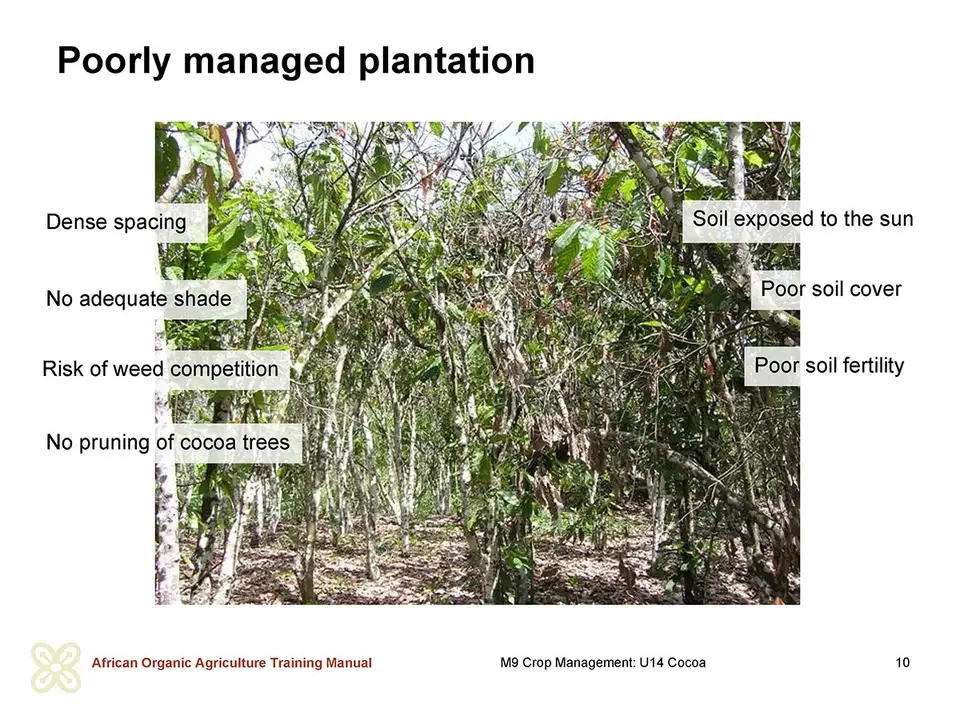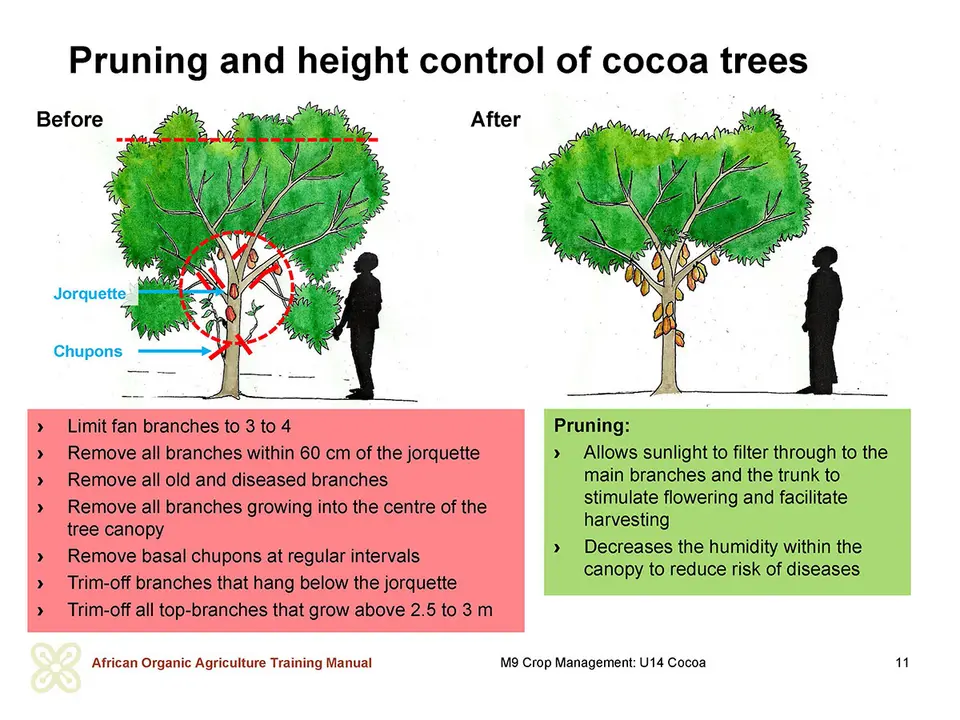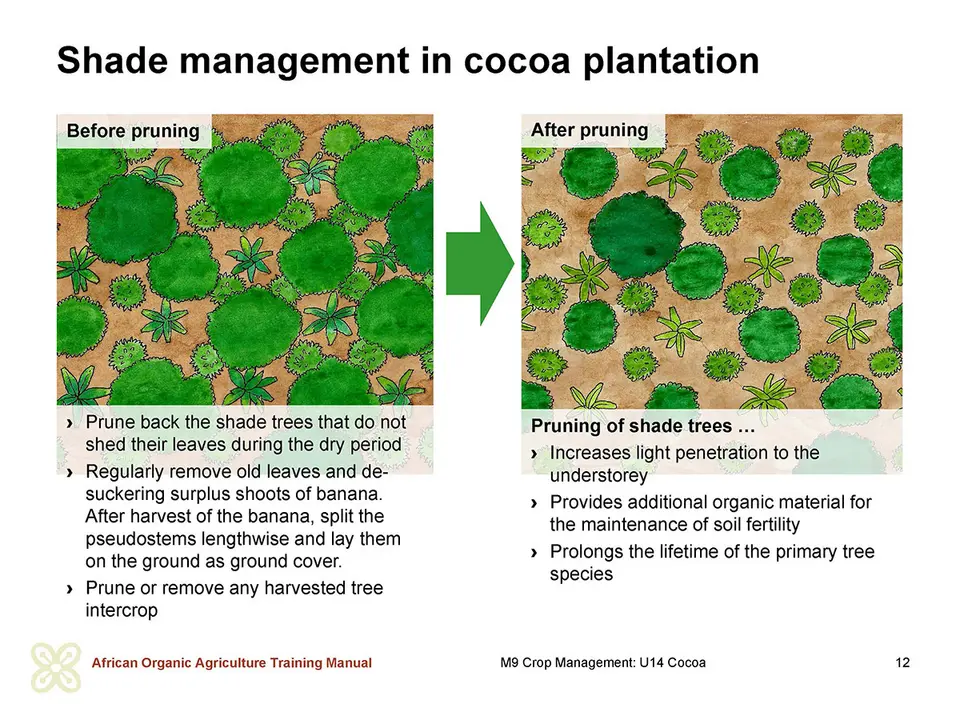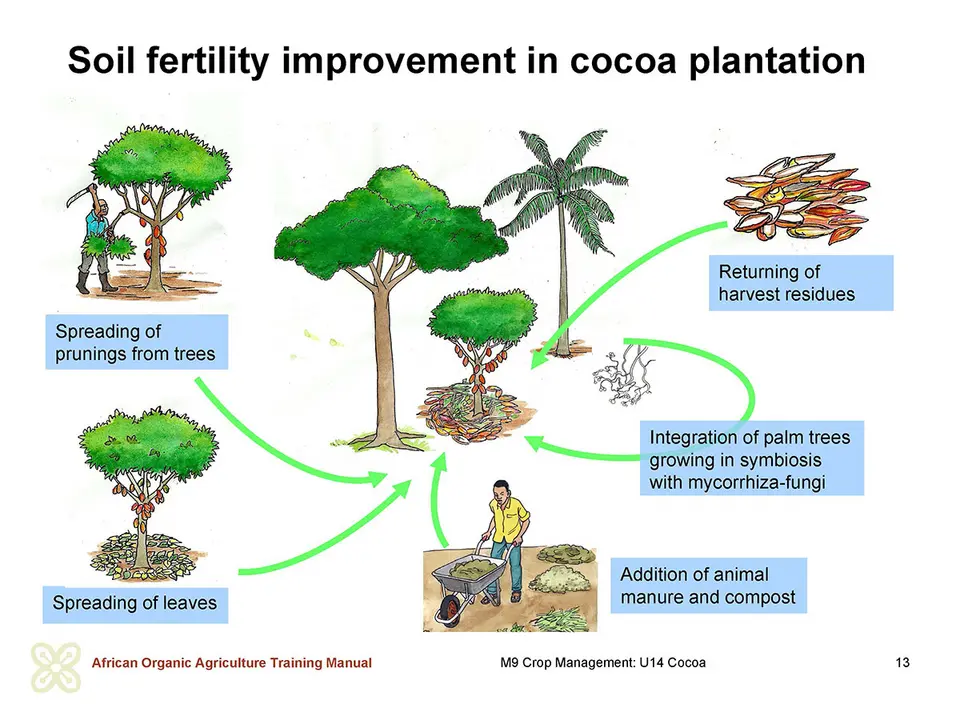Maintenance of cocoa plantations
Proper maintenance of cocoa trees during the early stages of growth improves later yields of the plantation. For good development young cocoa plants need favourable growing conditions with the soil protected from the sun, little competition from weeds, proper pruning, adequate shade and improved soil fertility.
Soil protection and weed management
In a sustainable cocoa plantation the soil is covered mainly by spontaneous vege-tation and cocoa leaves, which protect the soil against erosion. However, leguminous cover crops can also be grown in between the cocoa trees. Weed control is critical in the early stages of establishment in order to avoid competition with young cocoa plants for soil nutrients and water. Weeding also increases air circulation and reduces relative humidity and thereby reduces the incidence of black pod disease. Normally when the canopy is formed, weed growth is completely suppressed. Traditionally weeding is done manually by slashing around trees.
Pruning and height control
The basic aim of pruning cocoa trees is to encourage a tree structure that allows sunlight to filter through to the main branches and trunk (what is known as a jorquette) to stimulate flowering and facilitate harvesting. Young plants should develop a jorquette at a height of about 1 meter. However, the jorquette-height varies significantly from tree to tree. It has been found that increasing light intensity decreases the jorquette-height. If a jorquette is considered too low, it can be cut off. The strongest of the re-growing chupon can be selected and all others removed. In due course, this chupon will produce a jorquette at a higher level. Vegetatively propagated plants generally form a jorquette at ground level. Fan branches should be limited to 3 to 4 to allow more light to enter and decrease the humidity within the canopy. Basal chupons should be removed at regular intervals and all lower branches that form or bend below the jorquette should be trimmed off.
Furthermore all branches within 60 cm of the jorquette, all old and diseased branches and branches growing into the centre of the tree canopy should be removed. This should be done at regular intervals through maintenance pruning. All prunings should be left in the field to rot down, except the diseased ones.
Shade management
Natural forest systems have an underlying annual rhythm determined by, among other things, temperature and rainfall patterns. A number of upper storey trees of the forest system lose their foliage for some weeks or months during the dry season. In the case of cocoa, this rhythm is the more pronounced, the further away the plantation is from the equator. Thus, all the maintenance work carried out should be in harmony with the developmental rhythms of the entire system.
To further increase light penetration to the understorey plants such as cocoa, the shade trees that do not shed their leaves should be pruned back in this period. In addition to increasing light penetration, pruning also provides additional organic material, which contributes to the maintenance and enhancement of soil fertility. Pruning indirectly improves soil texture and the abundance of earthworms. Periodic rejuvenation by pruning also prolongs the lifetime of the primary species.
If reduction of shade cover and exposure of cocoa trees to light is done about 6 months before the expected main harvest, it positively influences the generative phase of cocoa and stimulates flower formation. Rejuvenation of maturing plants enhances intensive sprouting and accelerates the rate of growth in the whole system. Bananas that are grown as intercrops between cocoa should be regularly maintained by removing old leaves and de-suckering surplus shoots. After banana harvest, the pseudostems should be split lengthwise and laid on the ground as ground cover. Any further harvested tree intercrop should be pruned or removed to contribute to increasing light penetration.
Soil fertility management
One of the most important measures for the improvement and maintenance of soil fertility is the continuous addition of organic material, both woody and fresh plant materials such as mulches. Part of this material comes from pruning of trees and from harvest residues, for example when cocoa pods are returned to the plantation and distributed evenly over the soil surface. By ensuring consistent use of prunings and pods within the plantation, soil fertility can generally be maintained for successful organic cocoa production.
Many palm varieties are in a position to actively make phosphorus and other nutrients available to other plants through symbiosis with mycorrhiza-fungus. It is, therefore, recommended to integrate suitable palm tree species into the cultivation system wherever possible.
Many farmers eliminate big trees by ring barking. This practise is not recommended because the forced slow die back process has a negative influence on the whole plantation.
Application of animal manure and compost is very beneficial in cocoa plantations, as they provide nutrients and improve the soil structure and its capacity to hold water and nutrients.
Group activity on soil fertility management
Take the farmers to a cocoa plantation and ask them to characterize the following key criteria for soil fertility management:
- Plant diversity within the plantation
- Availability of mulch
- Use of potential mulching materials
- Organic matter content of the soil (darkness of the soil)
- Use of other sources of organic material such as compost
Discuss recommendations in the plenum on how the production of organic matter and hence soil fertility can be enhanced within the plantation.




 tap and then scroll down to the Add to Home Screen command.
tap and then scroll down to the Add to Home Screen command.